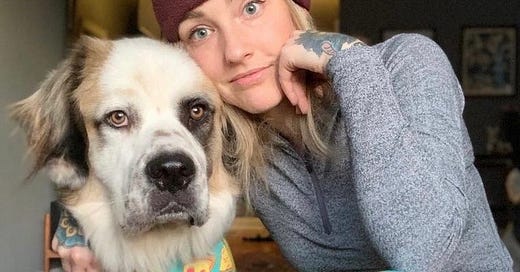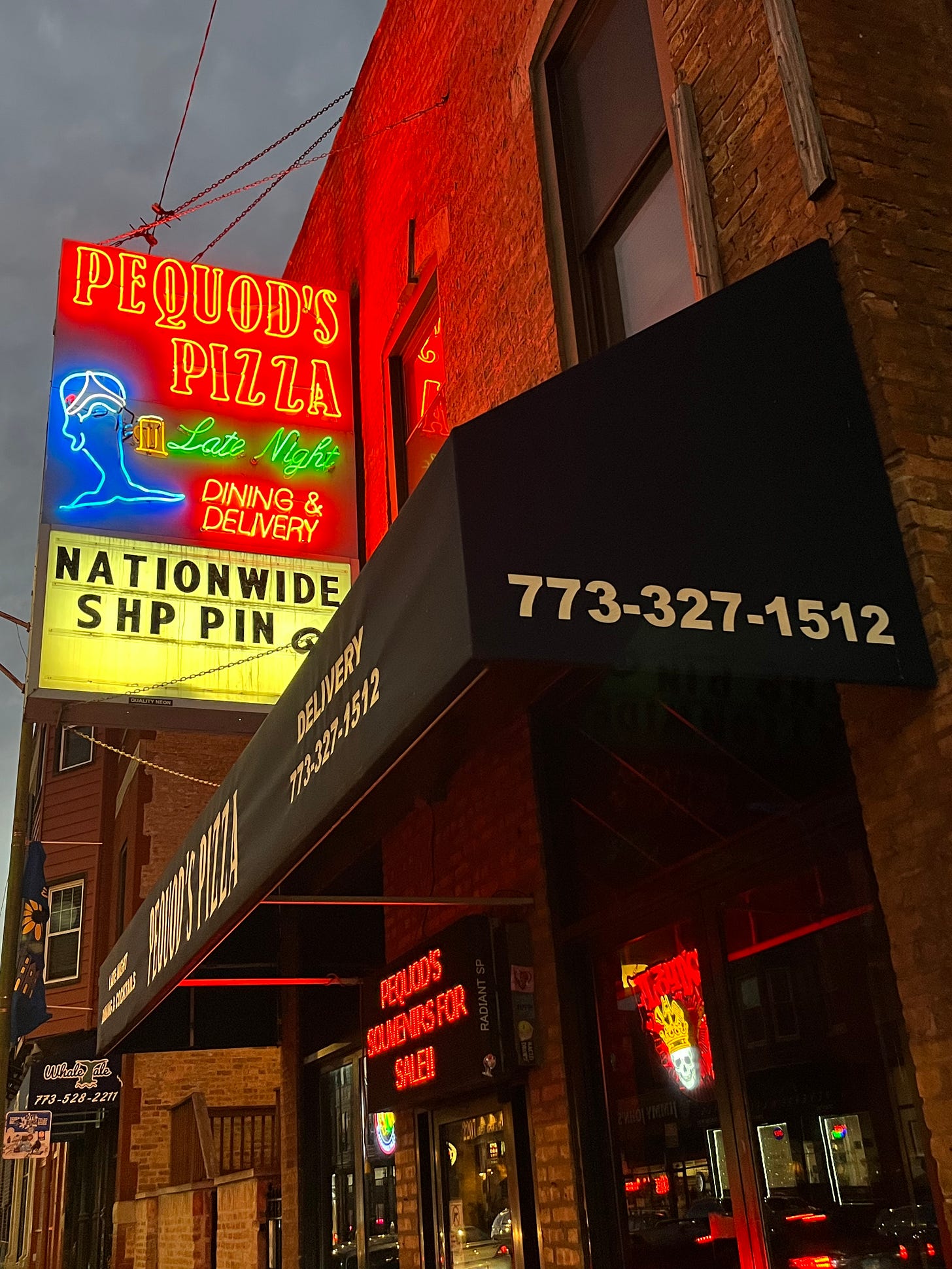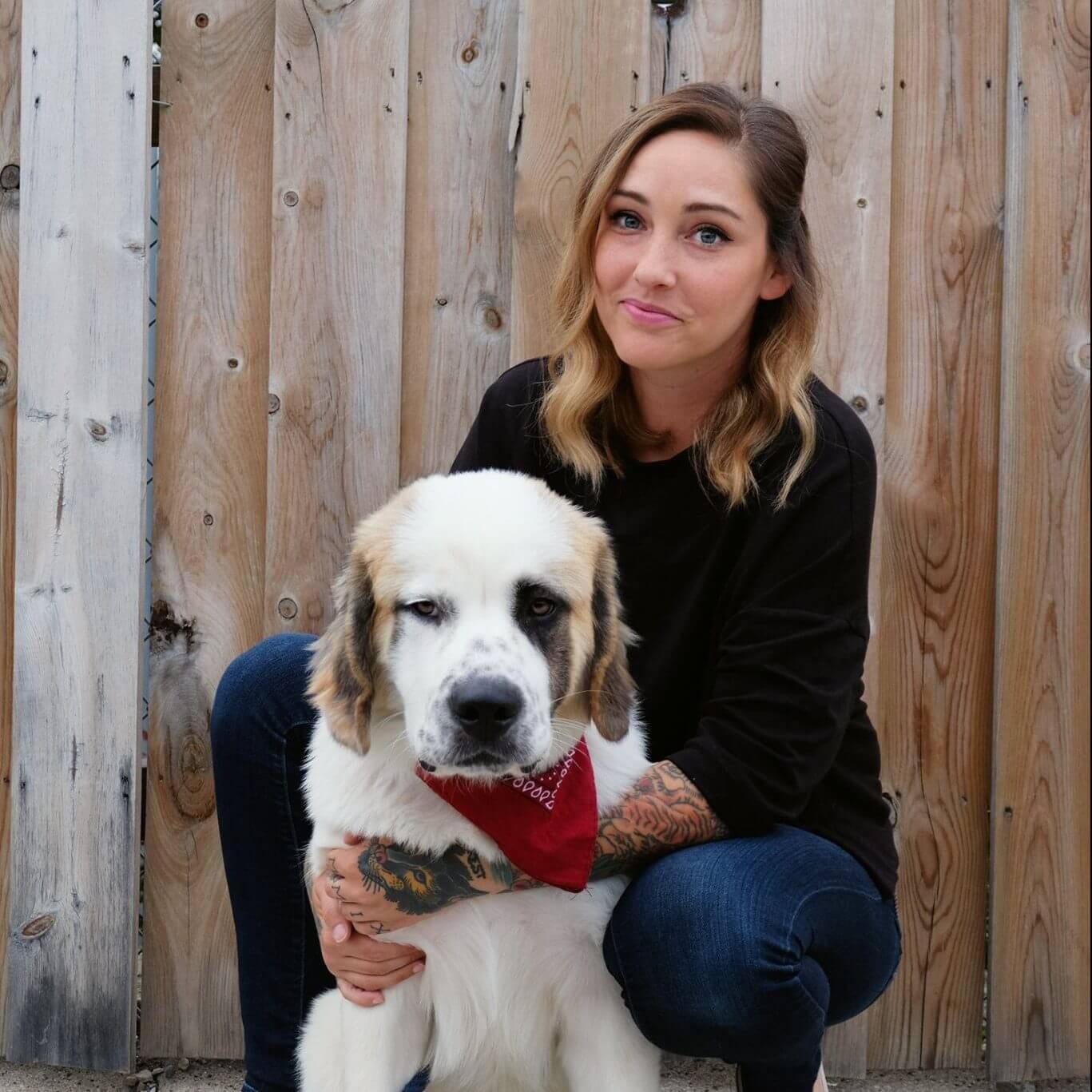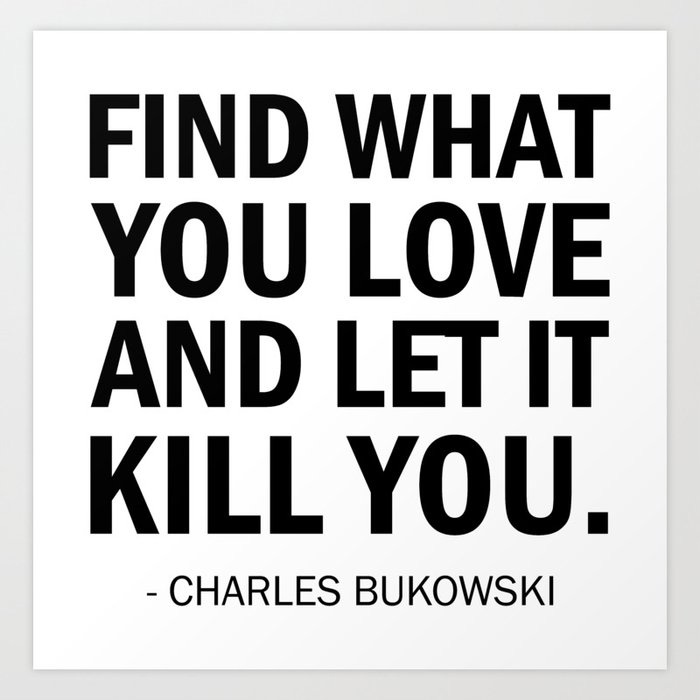One of the things I was super excited about when I started this was something I’m obviously calling “Eating Pizza With a Cool Person”. The idea is pretty simple: I reach out to someone I admire who is doing helpful, unique or interesting things in Chicago, offer to take them out for pizza, and then we have a conversation.
Heather Owen is the Executive Director and Co-Founder of One Tail at a Time, one of the city’s biggest and best animal rescue organizations. She was gracious enough to meet me at her favorite pizza place, Pequod’s Pizza, to split a cheese pizza and talk about some of the wonderful things that she does.
CPN: Where did you grow up?
Heather: Buffalo Grove. I was born in the Palatine area, and then Buffalo Grove. After high school I went to college at DePaul. Then I went to law school at Chicago-Kent College of Law, and I’ve been here ever since.
CPN: Do you remember your first favorite pizza?
Heather: Yes! Barnaby’s. Have you been?
CPN: I have not actually!
Heather: That would be a good one to check out. And I remember it was so cool because when we would go there as kids there was this little window where kids could watch them make the pizza. So we’d go in this little room area to watch them make the pizza and I thought that was so frickin’ cool. And the pizza is really good. I like the cornmeal crust. The other place I loved was called Bill’s Pizza in Mundelein, because they had peanuts you could eat and then throw the shells on the floor.
CPN: As a kid that’s just the best.
Heather: I haven’t been there in a long time but that’s the one thing I remember.
CPN: Do you remember your first time having Pequod’s?
Heather: No! I definitely remember having Burt’s in high school and middle school when my parents would take us. But I don’t think I had Pequod’s until probably college. Maybe even later.
CPN: So why is Pequod’s your favorite pizza?
Heather: I like deep dish. And I like cheese. I’m not a deep dish all the time person, so it’s like a treat meal. So if it’s like, oh, well I get to have a treat, then this is my favorite deep dish. It just always has been a treat. And it’s just like classically Chicago too. It’s not a chain, or somewhere that you can go to anytime.
CPN: That’s a perfect segue. What do you love about Chicago?
Heather: That’s a hard question this week. Chicago is tough.
CPN: I’ve got a follow up, so we can definitely get into that.
Heather: Every time I travel my biggest complaint is when a city isn’t walkable, and I’m in Logan Square, so I can walk anywhere. Anywhere I need to go I can just grab my dog, or just go out and walk places, so I love that so much. And each neighborhood has a totally different vibe like, you can go to Andersonville and walk all over and I feel like I’m in a totally different city then when I’m in Logan Square. I love the diversity and the people. And the food is incredible. Other than maybe New York, I don’t know that there’s another city where you could say the food is better.
CPN: What do you think could be better about Chicago?
Heather: Oh my God. This list goes on and on. So I’m dealing with a lot of political stuff right now, and so the frustrations of having to know someone to get things done has been really difficult. Also this balance of being like, what I’m doing is really important and I’d like some attention, but also knowing that there’s so many other things going on that take precedent. So do I just be quiet and let them do their thing? Or do I make noise so that we all get a little piece of attention? So the political shit is not my favorite. I think we can better manage our city, and I’m very hopeful for the current administration but also very frustrated. And for the first year ever I’m just over the long winters. So I’m going to spend a couple weeks elsewhere in January and February and work remotely because it’s brutal.
CPN: When you move away and live somewhere warm and then you come back, it’s even worse.
Heather: I can imagine. I’ve always loved the winter, especially because I’ve always had winter breed dogs so they like to be outside. So I’m like, okay, I’ll get all the gear and we can go on hikes. It’s nice to be outside in the winter and enjoy it, but it’s just too long. Like a month shorter and I’d be good.
CPN: So where did the initial idea for One Tail come from? What did you see going on in Chicago to make you feel like, I don’t like what I’m seeing right now?
Heather: I’ve always loved animals. I always loved dogs. We’ve had dogs since I was like two years-old and they were always my best friends. I got a dog when I was 20, and we bought it from a breeder. And I didn’t really know about rescues or shelters, which is due to my own ignorance. But then I learned about all of these things in the process of owning this dog and I was just appalled at the way we treat companion animals. And so I ended up feeling like now I want to volunteer to make sure I’m not contributing to the problem. I went to Chicago Animal Care and Control for the first time probably in 2007, and at that time we were taking in so many animals and euthanizing them. The year we started One Tail at a Time we euthanized over 13,000 animals in the shelter (emphasis mine). You’d walk in and it’s just like chaos and sadness. The thing I always feel like when I walk in there is I can help. I could just go home and be like, well I could help but I’m tired. That first initial feeling of realizing, oh, I can help, is really exciting. So I’m always trying to build on that. I can help.
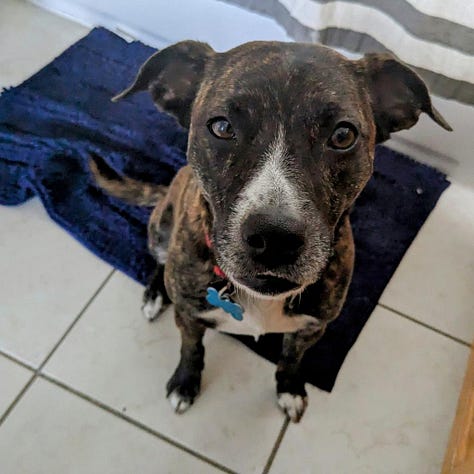
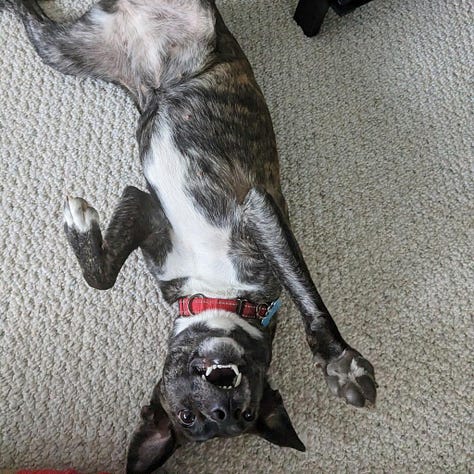
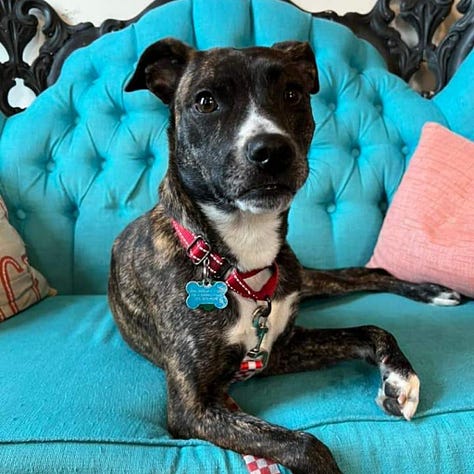
CPN: Where did the idea for the name come from?
Heather: Oh, I hate the name so much first of all. Like every year I’m like, can we rebrand? I hate the name.
CPN: I think it’s too late.
Heather: That’s what everyone tells me. It’s just too cute, you know. It doesn’t fit our brand. We’re not a cutesy brand.
CPN: Do you have a better name? Have you thought of one?
Heather: Not really. But I would come up with something. A little cooler. A little edgier. But I think the idea was just, when we started, we had no money. And we had no building. I was in school and no one had a ton of time to contribute so it was like, if we could just save one dog that’s good enough. So it always about that one, specific animal. They’re an individual and we’re going to get them everything they need. And that’s what we can do today. And tomorrow hopefully we can do more and do better. But if one at a time is all we can do then that’s what we’ll do.
CPN: Did you start by yourself? Or who else started with you?
Heather: With some friends. I was volunteering with a different group and felt constrained by some of their programming and was like, I want to do this better. Then I grabbed people that I thought could make that happen. A really good friend of mine, Andrea. And then a couple, Anna and Jeff. And then my friend Brian who I went to law school with. So it was the five of us. Over the years they either like, moved away, or they had kids or other jobs or whatever. So I’m the only one still in it. But they’re all still involved in some way.
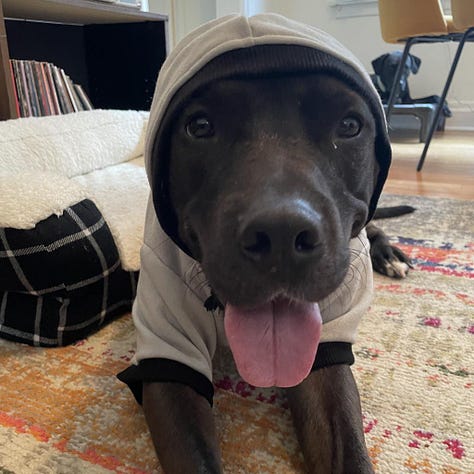
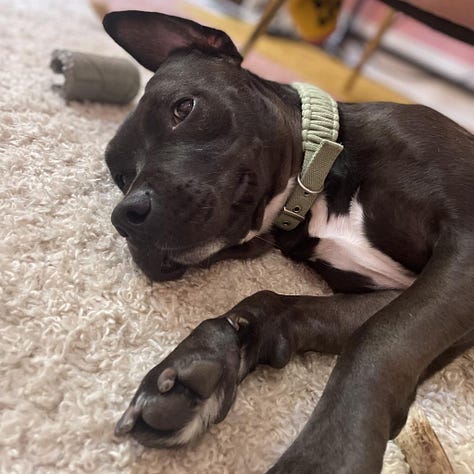
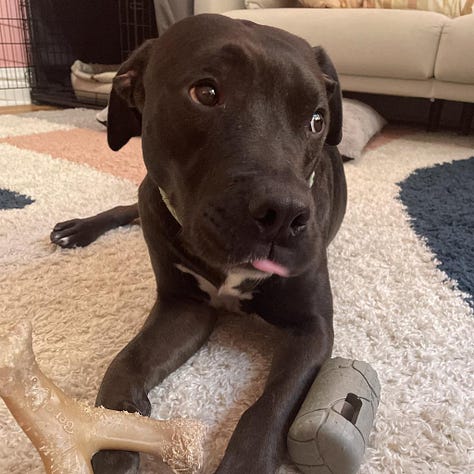
CPN: How many employees do you have now?
Heather: Too many. I forget. Somewhere between 26 and 30. It’s just constant growth. Not where I thought we would be, but I’m also so grateful this is where we’re at. My whole thing is always let’s do this, but then let’s do it better and more efficiently next year. So we’re always looking at how can we make things cheaper. How can we make it more streamlined. How can we shorten everything so we’re able to cycle through animals more quickly. So the biggest thing we did is we opened our own vet clinic. When we started we would just call up local clinics and be like, can we bring our animals to you? Will you give us a discount? And some of them were so nice and so kind but eventually they were like, it’s too many animals and they have so many problems, can you please stop sending them to us. Which, fair enough. So I thought we could either keeping paying exorbitant prices or we could just do this on our own. We’ve done so many other crazy things so let’s just start a vet clinic. And we did. So that’s where most of our staff is. We have three veterinarians. I think five vet techs. A medical director.
CPN: What do you think has gotten better since you started One Tail?
Heather: The data speaks for itself. We’re taking in less animals in shelters. Which is really good news. One of the biggest things I think, and this is something the entire country has done, is to stop taking in feral cats. Animal controls started as catch and kill really. They’d just round up all these animals to bring them in and kill them. And then we started being kinder and opening up human societies but it was still, let’s round up all the animals and sort them out. And feral cats always got the short end of the stick because once they’re in the shelter you can’t touch them. And no one is going to adopt them. So that has always been the number one population that’s being killed in shelters. And if you take them from where they’re at then other strays will just replace them. They breed like crazy. And they’re smarter than us. So we got wiser and just started spaying and neutering them, then putting them back. That way more don’t come in and you have more of a controlled population. We’ve also just started helping people keep their pets. There’s a component that used to be, anyone who came in to surrender their pet is a bad person. And we’re like, fine. Then you don’t deserve this animal so we’re going to take it away and give it to someone else. But then we started listening to people and realized that a lot of the people surrendering their pets were doing it because they had a hardship, or a nuanced hardship. Like, I lost my job. It’s so intersectional because I’ve taken in animals from people who were deported. I’ve taken in animals whose owners were sent to jail for something completely petty like marijuana. There’s so many times where it’s just like, this animal had a fine place and a fine owner but now they’re a victim of something else going on in our society. So there’s a lot of that. And there’s a lot of housing stuff. Affordable housing is a big issue. And a lot of landlords just don’t allow pets. So if you can’t afford to go somewhere else and all of the units in your building say no dogs, or no pitbulls, what are you going to do? You need to live somewhere with your pet and with your family. So realizing that, and starting programming to help people keep their pets is solving one of the problems we can. I can’t solve…I can’t get rid of ICE. Or change the prison system. But I can help people pay for pet deposits or emergency care or costs like that for their pet. And more people are adopting every year. So that’s great. In the country and even in our city, we’re talking about adoption in a more marketable way. So a lot has gotten better.
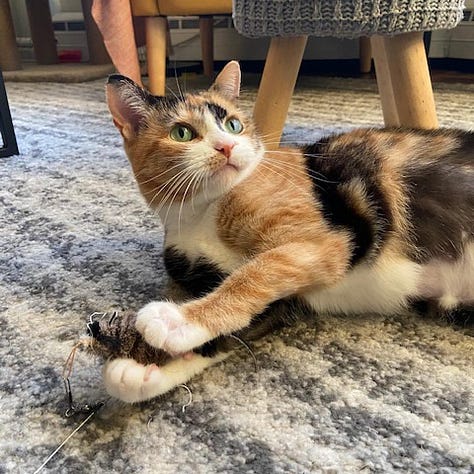
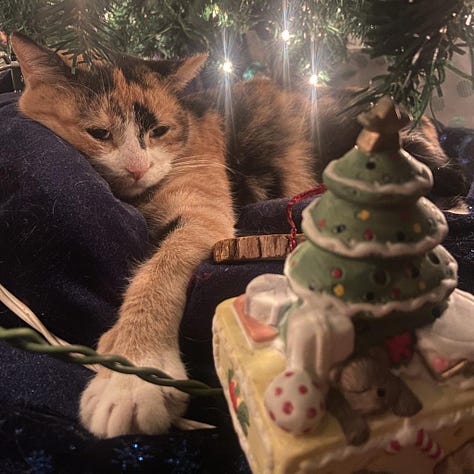

CPN: What frustrates you? Or what do you still want to see improve?
Heather: That’s a hell of a question. So much. Every day I run into the same things that anyone doing advocacy work runs into, which is that most of the systems that were built were not built for the kind of change we want to see. So it’s a question of, can you even get there within the system or do we need to tear it all down and start from scratch? Again, we started animals controls as a public safety for rabies control, but we don’t need that anymore because we don’t have a rabies problem anymore. So why are we still warehousing animals in one big shelter? For example Chicago Animal Care and Control is in an industrial corridor that is nowhere near public transportation and it’s hard to get to but it has all the animals there. Why don’t we have small adoption centers tucked away in every neighborhood? Why aren’t we doing the same business models as pets stores or puppy mills? Why aren’t we more tech savvy? So I think a lot of the issues are internal in that we don’t help ourselves and we’re trapped in the system. Also in Chicago specifically our budget for animal control is abysmal. It’s six million dollars. Whereas like the public park system, or the park district, is thirty million. So it’s a fraction of a lot of other things. Which, I totally understand priorities. And having animals is usually last on the list. But we need to do at least a little bit better in prioritizing them. And also recognizing that people are happier with their pets. Pets and people and intertwined, so it’s not like we’re just helping dogs. You help dogs, and you help people. So that connection we can be better at. I also look at what I can do better all the time. We ignore a lot of demographics. Like a lot of rescues and shelters don’t have Spanish speaking staff. So that’s something we’ve been working on a lot, making sure that someone in every department speaks Spanish so we can help out our Spanish speaking neighbors. I mean, why wouldn’t we? We can be better at diversity and inclusion. The number of black veterinarians is less than one percent. And that’s not veterinary hospitals in most of our black neighborhoods in Chicago. So access to care, and seeing that reflection of professionals in your demographic just doesn’t exist for a lot of people. So we need to work on that. We need community support. So people who can adopt, should adopt instead of buying a Doodle or a French Bulldog. French Bulldogs are actually a really good example of what we’re doing wrong. We look at pets as something that you put on Instagram sometimes instead of a member of the family. And French Bulldogs, English Bulldogs, a lot of the animals we breed so much are really unhealthy and come with a lot of behavior problems. So you’ll get someone who buys a dog like that and then faces one of those problems and tries to surrender them to a rescue. That’s not how this should work. We should be here for the people that truly need us. People can do better. The community can do better. Rescues can do better. Shelters can do better. Politicians can do better. We can all do better.
CPN: What do you think when you look back now at all you’ve accomplished and all the animals you’ve saved?
Heather: You caught me maybe on a bad day.
CPN: Is it possible to take those moments? Or do you feel like, there’s still so much more that you want to do so it’s hard to appreciate the things you have done?
Heather: Right now that’s my biggest thing that I’m working on personally. Because I see my staff do it, where they’re just bummed about something but I’m like, “Look what you did this week! Look at all the animals you saved!”. And they’re like, “Yeah, I know, but…”. And I have to make them stop and celebrate. But when it’s my turn I do the exact same thing. So I’m trying to lead by example a little bit better. When I see people that have a dog from One Tail, or a cat, and I see how much they love them, those are the moments when I’m like, “Yes! We did it!”. So my parents are a good example. They adopted their first rescue dog three years ago. And they’re in their 60s, so to bring that to them was really exciting. And my dad has allergies so they were like, we need a low shedding dog, and we need this and that because we have grandkids. So I said let me find you the right dog. And they were kind of skeptical but I brought them this dog, and he definitely sheds, so I broke a few rules. But every time I go there my dad is like, “This is the best dog in the world!”. And he’s always talking about how much he loves him and how he has all these friends in the neighborhood and he stops and gets treats from all the houses. So just seeing how they have that relationship, and how much joy that Wolfy brings to my parents house, those are the moments for me where I’m like; I did it. And especially when it’s a dog that would have been euthanized. I have a friend who adopted a dog from us, his name is Riggins, and he was in one of the worst shelters there is. He definitely would have been euthanized. She adopted him, and he’s a Pit Bull. He just passed his Canine Good Citizen test, so he’s going to be a therapy dog. He has titles in nose work. He’s this amazing, incredible dog that’s giving back to the community, and he literally would have died in there. So those are the moments when I can appreciate it.

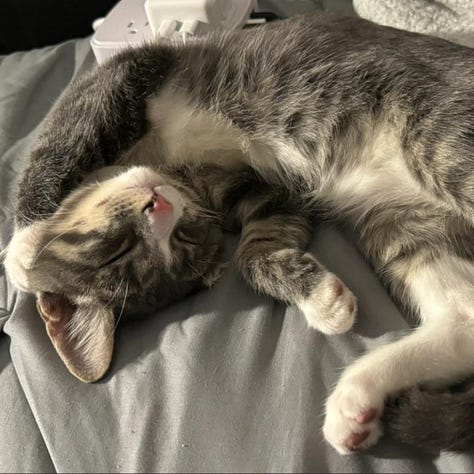
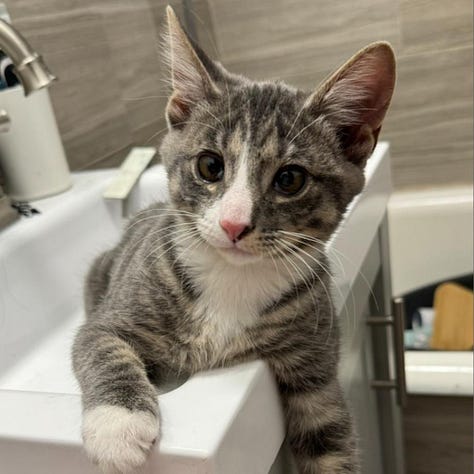
CPN: Then next question I was going to ask you is what’s it like when you see a One Tail dog on the street or at a park somewhere?
Heather: It’s so exciting. Especially if it’s a dog where I know their past, and I know where they came from and what could have been for them, and then to see them thrive. I was talking about it with a friend because through her rescue she just adopted a dog that went to an heir of a Chicago food company and it’s living the life. Like going on private jets and stuff like that. And this dog was literally about to die. So the fact you can change someone’s life with kindness is very powerful when you see that. There was also this Parvo puppy, one of the first Parvo puppies that we saved, and this was over six years ago now. And he cost over $10,000 and tried to die so many times. And I was like, is this the right thing? But now every year they send me a photo of him. And he’s always on a boat, or going on trips. And he’s a little guy so they take him on planes and stuff. So I’m like, if we didn’t do this then he wouldn’t be lighting up this families life and living way better than me.
CPN: So what was your first dog, or the first dog that made you fall in love with dogs?
Heather: My first dog was Shaggy. When I was two or three my parents brought him home. Old English Sheepdog. He was like 65 or 70 pounds. So Imagine being three years-old and just loving dogs and having this giant furry thing. That was so exciting to me. And I was always a little bit of a weird kid, so I had a friends but I was, you know, a little weird. So my dogs were always me best friends. And to be able to go home and play with my dog, and walk my dog, and be so excited about it was really important to me. And then then when he died we didn’t have a dog for a while. That was really hard, and I don’t think I realized how hard it was until we got our next dog. That was Walter, another Old English Sheepdog. And then again I was just like, this dog is my best friend and I was so obsessed with him. And then at 26 I adopted Rudy. Who I would call my heart dog. My soulmate. And he was my first dog that was my own as an adult. And he awful! Like so poorly behaved. But I just loved him so much. And I had gotten him on the day he was scheduled to be euthanized. I remember I told them I wasn’t going to come. But then I called them on the way, and this was so long ago that I don’t anyone really used text messages or whatever at that point, but I was like, “I’m coming! Please don’t euthanize this dog!”. And then the whole way here I was racing and I didn’t know if I was going to make it. And I made it. And I wasn’t even supposed to adopt him. But then I came in and saw him and was like, okay. This one is mine. Rudy was amazing. And now I have Trout. Also a great dog.
CPN: Last one. What is it like to realize a dream?
Heather: It’s amazing. I feel very lucky. I think about it a lot because it’s really hard, you know there’s that meme that people steal all the time that’s like; find what you love and let it kill you. That’s what I’ve done. It’s impossible to unplug. I work all the time. And sometimes that’s great. And sometimes that’s hard. So the dream is difficult sometimes, but I wouldn’t have it any other way. I can’t imagine ever doing anything else. I can’t imagine leaving the industry until we feel like we’ve solved the problem or at least gotten better. I also feel immense gratitude. Because I get a lot of the credit for what we do, but I call us a community organization because most of what we do is run by volunteers or fosters, or donors, or adopters. It’s not possible without what they put in. And we have volunteers that come like three, four, five times a week. We have fosters that have had dogs in their homes for over a year. The dedication that people put into this is amazing. And for them to trust me and my team to run the thing they’re putting their time into is really special. And it’s what makes me want to be better every day and do better. Because I’m working with the coolest people at the coolest organization and I just feel super lucky and super grateful.
To find out more information about One Tail at a Time you can check out their website right here.
For more information about Estelle, Tango, Hot Cocoa, McCall, and all of the animals currently available for adoption at One Tail you can go right here.
I’ve been a huge admirer of One Tail for a very long time and if my family didn’t currently have our very own spazz dog who doesn’t get along well with other dogs it’s safe to say we’d have probably adopted from them at least 15 times by now.
As far as I’m concerned Heather is not just one of the most kind and compassionate people in Chicago, but quite possibly the entire universe. Unfortunately, my interview with her ends with some major controversy.
As we were wrapping up our meal I noticed two discarded crusts on Heather’s plate (she even offered to let me take a picture of them, which I should have). For anyone who has never had Pequod’s Pizza before their signature move is to layer the cheese out beyond the crust so that it rests against the side of the pan as it bakes and gets extra crispy and toasty and salty (which is something that’s also typically done on most Detroit-style pizzas you get these days). It’s absolutely wonderful. And to some people it’s the best part of the entire pizza.
When I asked Heather about the crusts she told me that not only does she never eat them (from Pequod’s or Burt’s), but as far as she’s concerned caramelized is just another word for burnt.
Never meet your heroes.
While listening back through the recording of our interview I noticed a part of our conversation I initially somehow missed where Heather told me she likes to get asked weird questions. This one popped into my head, so I sent it over to her (and apologies to whichever one of my friends initially thought this up with me, I cannot remember who it was for the life of me).
CPN: There’s a magic pizza box in your house that contains your dream pizza/the most delicious pizza you’ve ever had in your life. You can open it anytime you’d like, and it will always be full. However, any time you open it there will always be bees inside and they’ll fly out and sting you. What is the number of bees that would prevent you from ever opening the box?
Heather: Incredible question, and I’m afraid my answer is going to be so disappointing. The answer is one. One bee and I’m out. Now if cheese fries were inside? Let ‘em swarm.


